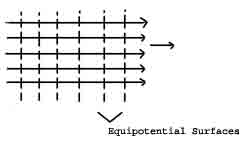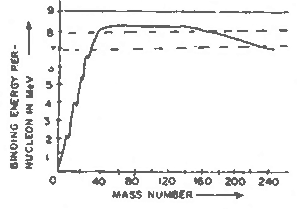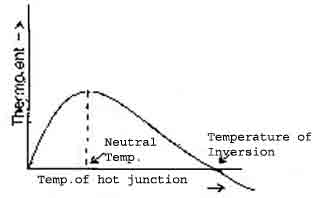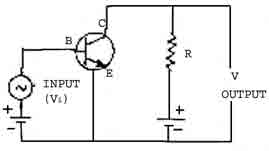|
CBSE ANNUAL PAPER - 2000
PHYSICS
(SET-I)
Time allowed : 3 hours
Maximum Marks :70
General Instructions :
(i) All questions are
compulsory.
(ii) Marks for each
question are indicated against it.
(iii) Question numbers 1 to
8 are very short - answer questions, carrying 1
mark each. These are to be answered in one or
two sentences.
(iv) Questions numbers 9 to
18 are short - answer questions, carrying 2
marks each. Answer to these questions should be
around 30 words each.
(v) Questions numbers 19 to
27 are also short - answer questions, each
carrying 3 marks each. Answer to these questions
should be around 50 words each.
(vi) Questions numbers 28
to 30 are long - answer questions, each carrying
5 marks. Answer to these questions should around
100 words each.
(vii) Use Log Tables, if
necessary.
|
| Q.1. |
Give a reason to show that microwaves are
better carrier of signals for long range
transmission than radio waves.
|
| Ans. |
Because of their smaller
wavelength, microwaves are not bent by objects
of normal dimensions. So microwaves are better
suited than radiowaves for sending a beam signal
in a particular direction.
|
| Q.2. |
How does the energy gap in an intrinsic
semiconductor vary, when doped with a
pentavalent impurity ?
|
| Ans. |
Energy gap decreases.
|
| Q.3. |
State the condition in which terminal
voltage across a secondary cell is equal to its
e.m.f. |
| Ans. |
In an open circuit,
terminal voltage across a secondary cell is
equal to its e.m.f.
|
Q.4. |
Draw an equipotential surface in a uniform
electric field.
|
| Ans. |

|
| Q.5. |
If
the number of turns of a solenoid is doubled,
keeping the other factors constant, how does the
self-inductance of the solenoid change ?
|
| Ans. |
As L a N2, self - inductance becomes four
times the original one.
|
| Q.6. |
What is the ratio of solar constant on the
surfaces of two planets, whose surface
temperatures are in the ratio 1 : 2
? |
| Ans. |
As S
a
T4 \ S1/S2
= [ T1/T2]4 = [1/2]4 = 1 : 16 |
| Q.7. |
The wavelength of light coming from a
distant galaxy is red - shifted. Is the galaxy
receding or approaching the earth ?
|
| Ans. |
The galaxy is receding away
from the earth. |
| Q.8. |
What is the angle of dip at a place where
the horizontal and vertical components of
earth's magnetic field are equal ?
|
| Ans. |
AS BV
= BH
\ d
tan = BV/BH = 1 or
d = 450
|
| Q.9. |
Briefly explain how the distance of an
inferior planet from earth can be determined ?
|
| Ans.
|
The angle formed at the
earth between the earth-planet direction and the
earth - sun direction is called the planet's
elongation. This angle is denoted by symbol
Î
as shown. When alongation attains its
maximum value Î, the planet appears farthest -
from the sun. In this position the angle
subtended by the sun and the earth at the planet
is 900.
rps / res = sin e
Distance of the
planet from the sun is
rps = sin e. res = sin e . AU
where res = IAU = average
earth - sun distance.
Image to be
inserted. |
| Q.10. |
Using Gauss' law, show that no electric
field intensity exists inside a hollow charged
conductor . |
| Ans. |
Imagine a Gaussian surface
near the cavity of a charged hollow conductor.
Electric field is zero at all points inside a
conductor. by Gauss's law, charge enclosed by
the Gaussian surface is zero. Consequently,
electric field is zero at all points of the
cavity.
|
| Q.11. |
Four capacitors are connected as shown in
the figure given below :

Calculate the
equivalent capacitance between the points X and
Y.
|
| Ans. |
The equivalent network is
shown below : Eqvivalent capacitance of the parallel
combination of 2 mF,
3mF and 10mF capacitors = 2+3+5 +
10mF
Now we have two 10mF capacitors
in series.
\ Equivalent capacitance
between X and Y = 10 x 10 / 10 + 10 = 5
mF

|
| Q.12. |
Draw the graph showing the variation of
binding every per nucleon with mass number of
different nuclei. State two inferences from this
graph. |
| Ans.
|
The energy responsible to
keep all the nucleons together inside the
nucleus or in other words the energy necessary
to break a nucleus into its constituent
particles is known as binding energy.
The variation of binding energy per
nucleon with the mass number of elements is
shown below :

The analysis of the curves shows that
(a) higher is the binding energy per
nucleon, more stable is the atom.
(b) combination of lighter nuclei into
heavier one corresponds to nuclear fusion. It is
because the total binding energy of the products
exceeds that of reactants.
|
| Q.13. |
In
a single slit diffraction experiment, if the
width of the slit is doubled, how does the (i)
intensity of light and (ii) width of the central
maximum change. Give reason for your answer.
|
| Ans. |
(i) As intensity
µ width of slit, so intensity gets doubled.
(ii) As width of central maximum
µ 1/slit width, so width of central maximum
is halved.
|
| Q.14. |
Draw the logic symbol of a 2-input NAND
gate. Write down its truth table.
|
| Ans. |
|
| Q.15 |
A
ray of light passes through an equilateral glass
prism, such that the angle of incidence is equal
to the angle of emergence. If the angle of
emergence is 3/4 times the angle of the prism,
calculate the refractive index of the glass
prism.
|
| Ans. |
Here A = 600, i1 = i2 = 3/ = 3/4A + = 3/4x600 = 450 AS
A + d
m = i1 + i 600 +
dm = 450 + 450
0r dm = 900 - 600 = 300
m = sin / A + dm /2 /
sin / A/2 = sin
/ 600 + 300 /2 / sin 600 / 2 = sin 450 / sin 300 = 1.414
|
| Q.16. |
A
concave mirror and a convex lens are held
separately in water. What changes, if any, do
you expect in the focal length of either ?
|
| Ans. |
Focal of concave mirror
remains unchanged when immersed in water. Focal
length of a convex lens in water will increase
because the refractive index of glass with
respect to water is less than refractive index
of glass with respect to air.
|
| Q.17. |
A rectangular coil of N turns and area of
cross - section A, is held in a time-varying
magnetic field given by B = B) sin w, with the plane of the
coil normal to the magnetic field. Deduce an
expression for the e.m.f. induced in the coil.
|
| Ans. |
B = B0 sin wt f= NBA =
NB0 A sin wt
E = df / dt = -
d/dt (NB0A sin wt)
= - NB0A w cos wt = E0 cos wt
E0 = NB0Aw = maximum value of
induced e.m.f. |
| Q.18. |
Draw the graph showing variation of thermo
e.m.f. of a thermo-couple with the temperature
difference of its junction. How does its neutral
temperature vary with the temperature of the
cold junction ?
|
| Ans.
|
Thermocouple is the
arrangement of two different metal wires joined
end to end so as to form a closed circuit.
The Sb-Bi thermocouple produces greater
emf than Cu-Fe thermocouple for the same
temperature difference hot and cold functions.

Application of thermocouples are
(i) In the generation of
thermoelectricity.
(ii) In the measurement of temperature
over a wide range. |
| Q.19. |
Derive an expression for the electric
potential at a point along with axial line of an
electric dipole.

|
| Ans.
|
V = V1 + V2 = 1/4pe0 a/r-a -
1/4
pe0 . q / r+a
= q / 4pe0 [ 1 / r-a - 1/r+a]
= q/4pe . 2a / r2 - a2
or v = 1/4pe0 . p/r2 - a2 [ q x 2a = p]
For a <<r, V =
1/4pe0 . P/r2 |
| Q.20. |
A
copper voltmeter is in series with a heater coil
of resistance 0.1 ohm. A steady current flows in
the circuit for 20 minutes, and a mass of 0.99
gm of copper is deposited at the cathode. If the
electro - chemical equivalent of copper is
0,00033 gm/coulomb, calculate the heat generated
in the coil.
|
| Ans. |
Here R =
0.1W, t = 20 min = 1200 s, m = 0.99 g, z =
0.00033 gC-1
As
m = zl t
l
= m/zt = 0.99 / 0.00033 x 1200 = 2.5
A.
H
= I2 RT +
(2.5)2 x 0.1 x
1200 = 750 J.
|
| Q.21. |
State Huygen's postulates of wave theory.
Sketch the wavefront emerging from a
(i) point
source
(ii) linear
source of light like a slit.
|
| Ans. |
Huygen's postulates of wave
theory are as follows : (i) Every point of the medium situated on
the wave front acts a new wave-source from which
waves, called secondary wavelets, originate.
(ii) The secondary wavelets travel in the
medium in all directions with the speed of
light.
(iii) The envelope of the secondary
wavelets in the forward direction at any instant
gives the new wavefront at that instant.
|
| Q.22. |
State the condition of total internal
reflection of light to take place at an
interface separating two transparent media.
Hence derive the expression for the critical
angle in terms of the speeds of light in the two
media. |
| Ans. |
Essential conditions for
total internal reflection are (i) Light should travel from a denser to a
rarer medium.
(ii) The angle of incidence should be
greater than the critical angle for the two
media.
Expression of critical angle : -
When a ray of light travels from a denser
to a rarer medium it deviates away from the
normal. The angle of incidence in denser medium
for which the angle of refraction is 900, is
called critical angle. At this situation.
rarer denser = 1 /Sin C
But rarer denser = Speed of light in rarer
medium / Speed of light in denser medium
Hence = Speed of light in rare medium /
speed of light in denser medium = 1 / Sin C
|
| Q.23. |
State the dependence of work function on
the Kinetic energy of electrons emitted in a
photocell. If the intensity of incident
radiation is doubled, what changes occur in the
stopping potential and the photoelectric
current. |
| Ans.
|
Energy
of incident photon = Maximum K.E. of
photoelectron = work function
hn = 1/2
mv2 max + Wo
Ek = 1/2 mv2 max = hn - Wo
Higher is the work function of the metal,
the lesser will be the kinetic energy of the
emitted electron.
If
the intensity of incident radiation is doubled,
stopping potential remains unchanged and the
photoelectric current gets doubled.
|
| Q.24. |
With the help of a labelled circuit
diagram, explain how will you determine the
internal resistance of a primary cell using a
potentiometer, State the formula used.
|
| Ans. |
The resistance offered by
electrolyte inside the cell circuit is called
internal resistance of cell.
Let there be a cell of emf E, internal
resistance r, used to draw current in a circuit
of resistance r. then
I = E/R+r
IR + Ir = E
Ir = E-V
Or
r = E-V/I
Or
r = (E-V)R/V .....(i)
EMF is maximum P.D. obtainable by a cell
when it is in open circuit.
The internal resistance of a primary cell
can be determined by potentiometer. The circuit
is shown below :

First insert infinite resistance from
Resistance box and find null diflection length
(l1). Since the cell is in open circuit.
E = Kl1
.............. (ii)
Now insert a know resistance R from
Resistance box and again find null deflection
lelngth (l2). Since now the cell is in closed
circuit so.
V = Kl2
............(iii)
By (i) r = (l1-l2) /R/l2
Thus internal resistance of cell is
determined.

|
| Q.25. |
A
short bar magnet of magnetic moment 0.9 joule /
tesla, is placed with its axis at 450 to a
uniform magnetic field. If it experience a
torque of 0.063 joule, (i) calculate the
magnitude of the magnetic field and (ii) what
orientation of the bar magnet corresponds to the
stable equilibrium in the magnetic field ?
|
| Ans. |
Given M 0.9 JT-1,
q
= 450,
p = 0.063 J
(i) Magnetic field, B =
p / m
sin = 0.063 / 0.9 x sin 300 =
0.99 T
(ii) For stable equilibrium, the magnetic
moment of the bar magnet should be in the
direction of the magnetic field.
|
| Q.26. |
A
conductor of length 'l' is connected to a d.c.
source of potential 'V'. If the length of the
conductor is tripled, by stretching it, keeping
'v' constant, explain how do the following
factors vary in the conductor :
(i) Drift
speed of electrons, (ii) Resistance and (iii)
Resistivity.
|
| Ans.
|
(i) Drift
speed, nd = eE/Mt
= eV/ml t When 'l' is tripled,
drift speed becomes one - third of the original
one
(ii) R = p l/a
When 'l' tripled,
resistance becomes 3 times the original one.
(iii) Resistivity
remains unchanged as it does not depend on the
length 'l'.
|
| Q.27. |
A
proton and an alpha particle of the same
velocity enter in turn a region of uniform
magnetic field acting in a plane perpendicular
to the magnetic field. Deduce the ratio of the
radii of the circular paths described by the
particles. Explain why the kinetic energy of the
particle after emerging from the magnetic field
remains unaltered.
|
| Ans.
|
r = mv/qb
rp/ra = mp/ma x qa/qp Now ma = 4 mp and qa = 2qp
\ rp/ra
= mp/4mp x 2qp/qb = 1/2 = 1:2
|
| Q.28. |
State the postulates of Bohr's model of
hydrogen atom. The electron, in a given Bohr
orbit has a total energy of -1.5eV. Calculate
its (i) kinetic energy, (ii) potential energy
and (iii) wavelength of light emitted, when the
electron makes a transition to the ground state.
( Ground state energy = -13.6
eV) |
| Ans. |
Bohr's Postulates (1) An
atom consists of a small and massive central
core called nucleus around which electrons
revolve. The centripetal force required is
provided by electrostatic force of attraction
between electron and the nucleus i.e.
mv2 / r =
KZe2 / r2
(2) The electrons are permitted only in
those orbits in which the angular momentum of
electron is an integral multiple of h /
2 p
, Where
h is plank's constant i.e.
L = m vr = nh/2p
where n = 1,2,3, ....
(3) An
atom can emit or absorb radiation in the form of
discrete energy only when an electron jumps from
higher energy level to lower energy level i.e.,
Numerical : Total
energy, E =- 1.5eV
(i) Kinetic energy,
T = -E= -(-15) + 1.5 eV
(ii) Potential
energy, V =- 2T = -2 x 1.5 =-3.0 eV.
(iii) D
E =
hn = hc/ l
\ l = hc/DE
But D E =
-1.5 -(-13.6) = 12.1 ev = 12.1 x 1.6 = 10-19 J
\ l = 6.6x10-34x3x108 / 12.1x10-19 = 1.0227 x 10-7 m = 1022.7 A
|
| Q.29.
|
For a given a.c. circuit,
distinguish between resistance, reactance and
impedance. An a.c. source of frequency 50 hertz
is connected to a 50 mH inductor and a bulb. The
bulb glows with some brightness. Calculate the
capacitance of the capacitor to be connected in
series with the circuit, so that the bulb glows
with maximum brightness.
|
| Ans.
|
Resistance :
It is the opposition to the flow of current by a
pure resistor.
R
= V/I
Reactance : It is the resistance offered
by a pure inductor or capacitor to the flow of
a.c.
X1
or X1 = Veff / Ieff
Impedance : It is the combined resistance
offered by LR - or CR - or LCR circuit to the
flow of a.c.
Z
= Veff / Ieff
Numerical : Here f = 50 Hz, L = 50 mH =
0.05 H,
XL = Xc or
2pfl = 1/2pfc
or C = 1/4p2f2L
= 1/4x9.87x(50)2
x 0.05
=
0.1 x 10-4F
Formula to be inserted.
|
| Q.30. |
Drawing a labelled circuit
diagram, explain the working principle of a
common - emitter transistor amplifier. State the
phase relation between input and output signals.
|
| Ans.
|
An npn
transistor used as a common emitter amplifier is
shown in figure. The emitter circuit is forward biased
while the collector emitter circuit is reverse
biased;. The input signal Vi is superimposoeod
on the forward bias. The load RL is connected
between the collector and emitter as shown in
figure.
When the signal is fed to the input
circuit, its positive half cycle increases the
forward bias of the circuit which in turn,
increases the emitter current and hence the
collector current. The increase in collector
current increases the potential drop across RL
which makes the output voltage less positive or
more negative. This means that as the input
signal goes through its positive cycle, the
output signal goes through a negative half
cycle.
The negative half cycle of the input
signal opposes the forward bias. This decreases
the emitter current and hence the collector
current. The decrease in collector current
decreases the potential drop across RL which
makes the output voltage more positive or less
negative. As the input signal goes through its
negative half cycle, the output signal goes
through its positive half cycle.
Voltage gain : The ratio of the output
voltage to input voltage is called the voltage
gain of the amplifier.
Voltage gain = V output / V input =
D
VCE / DVBE = DIC/DIB X R
output / R input
= Current gain x
resistance gain.

|